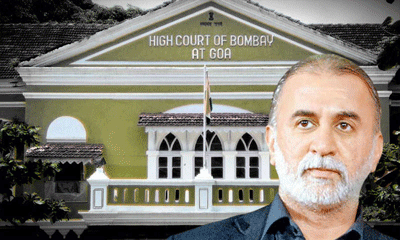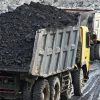Goa is abuzz with excitement as vintage bike and car owners, users, collectors and fans are decking […]

TARUN TEJPAL, A VICTIM OF TRIAL BY MEDIA?
In the News, June 12- June 18, 2021 June 11, 2021CHALLENGED: The acquittal of managing editor of news weekly Tehelka, Tarun Tejpal, who was charged with sexual molestation and a slew of other charges to do with his colleague at a five-star hotel at the Think festival in November 2013 has been challenged by the Goa government
Many individuals and organisation become targets of a trial by media. For instance, it may be recalled that there was several theories and reports after the reported suicide of Sushant Singh Rajput in which allegedly even the son of the Maharashtra Chief Minister Udhhav Thackery, Aditya Thackery (also the Minister of Tourism & Environment in his cabinet) was implicated. In the case of Tarun Tejpal we have here final year law students of the V M Salgaocar Law College in Panaji, PRASENJIT DHAGE and SHUKR USGAOKAR, examining and questioning the impact of trial by media on courts of law and the judiciary. Is the judiciary influenced by what is published and debated in the media? Has the media in India become irresponsible and undignified in its presentation of controversial cases like the one involving journalist Tarun Tejpal?
FORMER American minister and civil rights activist, Malcolm Little, famously known as Malcolm X, is known to have once remarked, “The media’s the most powerful entity on earth. They have the power to make the innocent guilty and to make the guilty innocent, and that’s power. Because they control the minds of the masses.”
PEEP HOLE MEDIA
Tarun Tejpal, the erstwhile editor of the magazine Tehelka, knew this. His brand of investigative journalism which often included sting operations exposing the misdeeds of the high and mighty, made waves, winning him both enemies and admirers. But even Tejpal, who at that time was one of Delhi’s most talked about journalists, could not in his wildest dreams have foreseen the media onslaught which ensued after a colleague at Tehelka accused him of sexually assaulting and harassing her in an elevator at the Grand Hyatt Hotel at Bambolim, Goa where Tehelka was hosting its THiNK festival, the news magazine’s official event, on the night of November 7, 2013, forcing him to resign from the post of editor-in-cChief of the news weekly he co-founded.
Tejpal has consistently maintained that it was a case of political vendetta by the ruling BJP government, given that he had been not just the ‘foremost critic of right-wing majoritarian politics,’ but also instrumental in conducting a sting operation which exposed corruption by the then NDA regime in defence deals, thereby leading to the resignation of Defence Minister George Fernandes and BJP leader Bangaru Laxman.
But irrespective of whether this is a case of a political party unleashing the wrath of its vengeance on Tejpal in the garb of an FIR to malign and target him, or just an instance of an investigative agency following the due process in prosecuting an accused and taking it to its logical conclusion, the fact remains that Tarun Tejpal was arrested on November 30, 2013 after his application for anticipatory bail was rejected and he remained incarcerated in jail for almost half a year till the Supreme Court granted him bail on July 1, 2014.
The case had made headlines given the fact that it had happened in the aftermath of the 2012 Delhi gang rape case (Nirbhaya rape case) and when a lot of debate and discussion was on about Indian attitude towards sexual violence. Tejpal, who had done cover stories on gender equality and misogyny, was accused of hypocrisy and double standards. He was branded a pervert, a molester, a sex fiend, and mercilessly vilified by the mainstream and social media.
As women’s groups and members of ABVP, the BJP’s youth wing, held street protests against Tejpal, the press went into a frenzy covering every development in the case, from the framing of the 12 volume, 2,864-page charge-sheet filed by the Goa Crime Branch which included the statements of 152 witnesses, to the framing of charges by the Sessions Court under IPC sections 341 (wrongful restraint), 342 (wrongful confinement), 354 (assault or criminal force with intent to outrage modesty), 354-A (sexual harassment), 354-B (assault or use of criminal force to woman with intent to disrobe), 376(2)(f) (person in a position of authority over women, committing rape) and 376(2)(k) (rape by a person in a position of control) in September 2017.
Both the Bombay High Court and the Supreme Court refused to quash the charges as prayed for by Tejpal who insisted that the complaints were fabricated, with the latter directing that the trial be completed in six months. The prosecution examined 71 witnesses and cross-examined five defence witnesses but was unable to establish the guilt of Tejpal and he acquitted of all charges by the fast track court on May 21, 2021.
HARASSED BY BJP?
But with Chief Minister Dr Pramod Sawant stating that the government will appeal against the decision in the High Court one wonders if Tarun Tejpal will ever be able to live the life of a fee man?
IN HIS seminal commentary on the ‘Laws of England,’ published way back in the year 1769, English jurist William Blackstone had written that “the law holds that it is better that ten guilty persons escape, than that one innocent suffer.” Fast forward two centuries and the House of Lords, the final court of appeal in Britain, in its celebrated decision Woolmington v. Director of Public Prosecution [1935 AC 462] held that “Throughout the web of the English criminal law, one golden thread is always to be seen, that it is the duty of the prosecution to prove the prisoner’s guilt.” Simply stated, every accused is presumed to be innocent until proven guilty by a fair trial and the benefit of every reasonable doubt should be given to the accused.
The stand taken by courts in our country is not very different. In Harijana Thirupala & Ors. v. Public Prosecutor, High Court of A.P., Hyderabad [2002 (6) SCC 470], the Supreme Court of India observed that:
“In our administration of criminal justice an accused is presumed to be innocent unless such a presumption is rebutted by the prosecution by producing the evidence to show him to be guilty of the offence with which he is charged. Further, if two views are possible on the evidence produced in the case, one indicating to the guilt of the accused and the other to his innocence, the view favourable to the accused is to be accepted. In cases where the court entertains reasonable doubt regarding the guilt of the accused the benefit of such doubt should go in favour of the accused.”
In Sujit Biswas v. State of Assam [AIR 2013 SC 3817], the Apex Court held that:
“Suspicion, however grave it may be, cannot take the place of proof, and there is a large difference between something that may be’ proved, and something thatwill be proved’…. In a criminal case, the court has a duty to ensure that mere conjectures or suspicion do not take the place of legal proof. The large distance between may be’ true andmust be’ true, must be covered by way of clear, cogent, and unimpeachable evidence produced by the prosecution, before an accused is condemned as a convict…”
SUO MOTO FIR
Yet, all of this was thrown to the wind, as the media donned the hat of police, prosecution, judge, jury, and executioner, all at the same time, and went with all guns blazing on the mere suspicion aroused by an FIR filed by Goa Police who took suo motu cognizance of the matter. Parallel trials were conducted in the editorials of newspapers and studios of news channels, who in their pursuit to rake in maximum readership and TRPs (Television Rating Points), seemed to have forgotten that an investigation and subsequently, a judicial trial was under way and the on going media blitz had the potential to interfere with the administration of justice.
In R. K. Anand v. Delhi High Court[(2009) 8 SCC 106], the Supreme Court defined a media trial in the following terms: “The impact of television and newspaper coverage on a person’s reputation by creating a widespread perception of guilt regardless of any verdict in a court of law. During high publicity cases, the media are often accused of provoking an atmosphere of public hysteria akin to a lynch mob which not only makes a fair trial impossible but means that regardless of the result of the trial, in public perception the accused is already held guilty and would not be able to live the rest of their life without intense public scrutiny.”
It is noteworthy that while the matter was sub-judice in the trial court of Goa, Times Now, a TV news channel aired a CCTV footage under the title ‘Never seen before video tapes’ which depicted two persons, whom the channel claimed to be Tejpal and the victim entering and exiting an elevator in a hotel lobby. The CCTV footage was repeatedly shown in the TV debate. In the debate on one hand the anchors interpreted the body language of the persons in the CCTV footage and on the other hand the panelists either attacked Tejpal or discredited the victim.
VICTIMS NAME REVEALED
The debate had neither any regard for the privacy of the victim nor the rights of the accused. Responding to the violations committed by the channel, criminal lawyer Rebecca Mammen John in The Wire noted ‘Section 327 (2) and (3) of The Code of Criminal Procedure makes it clear that rape trials shall be conducted in camera. It further states that “it shall not be lawful for any person to print or publish any matter in relation to such proceedings, except with the previous permission of the court. The footage that was aired yesterday is an exhibited document in the trial. In an on-going trial you cannot play any footage on your night show without the permission of the court. The court had not granted any such permission. On the contrary it has prohibited public viewing of the footage. Dear anchors: Got that?”
There is no doubt that the media has a duty to report about all events which might be of use or interest to the public. Indeed, given its role in keeping the people informed about the whereabouts and happenings in the world around them, the media can be rightly called the eyes and ears of the public. A criminal trial of a public figure is no exception.
IN FACT, one of the basic principles enunciated in the Madrid Principles on the Relationship between the Media and Judicial Independence, framed in 1994 by 39 distinguished legal experts and media representatives who met for three days in the titular city is that “It is the function and right of the media to gather and convey information to the public and to comment on the administration of justice, including cases before, during and after trial, without violating the presumption of innocence.”
But there is a huge difference between keeping someone informed and misinformed. As Justice R S Chauhan has written his article ‘Trial by Media: An International Perspective’ [The Practical Lawyer (2011) PL October S-38]:
‘Pre-trial publicity is injurious to the health of a fair trial. Even before the accused is arrested and tried, the cacophony of media proclaims the accused to be guilty. It may project irrelevant and inadmissible evidence as the gospel truth, thereby convincing the people about the guilt of the accused. It, thus, undermines the fundamental principle of common law that “every man is presumed to be innocent till proven guilty”. Once the accused is portrayed as a despicably depraved character, at times, the Bar may refuse to defend him. It, therefore, robs the accused of his fundamental right to defend himself. Such publicity also convinces the witnesses to custom-tailor their testimony to the prosecution case. Most importantly, the appreciation of the evidence by the public and the judiciary may differ. While the people are convinced of the guilt of the accused, the court, after meticulous examination of the evidence may acquit him. Such differences in perception weaken the faith of the public in the criminal justice system. Ultimately, pre-trial publicity undermines the criminal justice system and overturns the rule of law.’
And it is not just witnesses and advocates who are likely to be influenced by a media trial. In In Re M.V.Jayarajan [(2011) 4 KLJ 605], the Kerala High Court observed that “However stalwart they may be, Judges are also human beings. It requires intense and protracted training of the mind for a Judge to remain uninfluenced by such media exploits, particularly when it is the habit of every literate citizen to read the newspapers and watch the news channels and Judges are no exception. They cannot shut their eyes or mind to the spicy media trial and thereafter approach the case with total detachment and perfect equanimity.”
NORMS OF CONDUCT
It is pertinent to refer to the Norms of Journalistic Conduct, formulated under section 13 of the Press Council Act, 1978 by the Press Council of India, the statutory organization regulating the conduct of the Indian media. Paragraph 41(A) deals with ‘Trial by Media’ and clearly states that “Measures which are necessary for due process of law need to take precedence over freedom of speech. In a conflict between fair trial and freedom of speech, fair trial has to necessarily prevail because any compromise of fair trial for an accused will cause immense harm and defeat the justice delivery system.” Some of the guidelines framed are worth reproducing verbatim:
i) An accused is entitled to the privilege of presumption of being innocent till guilt is pronounced by the Court.
ii) The media reports should not induce the general public to believe in the complicity of the person indicted as such kind of action brings undue pressure on the course of fair investigation by the police.
ix) The media is not expected to conduct its own parallel trial or foretell the decision putting undue pressure on the judge, the jury, or the witnesses, or prejudice a party to the proceeding.
However, these Norms have remained paper tigers and the guidelines are honoured more in the breach than in observance. By sensationalizing a sensitive case which was sub-judice, the media unabashedly trampled over Mr. Tejpal’s right of reputation and privacy while possibly committing contempt of court. But what is truly disturbing is the impunity with which all this was done. Mr Tejpal, in all likelihood, will have to live the rest of his life in public ignominy, his past achievements all but forgotten, while being defined by one incident which though was never proved in a courtroom, will not be wiped away from public memory any time soon.
Article 21 of the Constitution of India, which is considered to be the heart and soul of the Constitution, speaks of the right to life and personal liberty. Judicial interpretation has expanded the scope of this article so as to include the right to a fair trial. It is precisely for this reason that courts in this country have by and large disapproved of the media interfering with the investigation and functioning of the courts and in the process impinging on the personal liberty of the accused, something which the courts have been ordained by the Constitution to protect with missionary zeal.
EFFECT ON JUDGE
In State of Maharashtra v. Rajendra Jawanmal Gandhi [(1997) 8 SCC 386], the Apex Court observed as follows:”A trial by press, electronic media or public agitation is the antithesis of the rule of law. It can well lead to miscarriage of justice. A Judge has to guard himself against any such pressure and he is to be guided strictly by the rules of law.”
In Manu Sharma v. State (NCT of Delhi) [(2010) 6 SCC 1], better known as the Jessica Lal murder case, the Supreme Court again cautioned about the dangers of a media trial:
“297. There is danger of serious risk of prejudice if the media exercises an unrestricted and unregulated freedom such that it publishes photographs of the suspects or the accused before the identification parades are constituted or if the media publishes statements which out rightly hold the suspect or the accused guilty even before such an order has been passed by the court.
- Despite the significance of the print and electronic media in the present day, it is not only desirable but the least that is expected of the persons at the helm of affairs in the field, is to ensure that trial by media does not hamper fair investigation by the investigating agency and more importantly does not prejudice the right of defence of the accused in any manner whatsoever….
…302. In the present case, various articles in the print media had appeared even during the pendency of the matter before the High Court which again gave rise to unnecessary controversies and apparently, had an effect of interfering with the administration of criminal justice. We would certainly caution all modes of media to extend their cooperation to ensure fair investigation, trial, defence of accused and non-interference in the administration of justice in matters sub-judice.”
HOWEVER, all of these warnings have largely fallen on deaf ears. Dignified journalism is a thing of the past; restraint and prudence have been given a go-bye; and a contest has emerged between the channels as to who is the loudest, fastest and most opinionated. And in this race of grabbing eye-balls and headlines, where noise triumphs over news, sensationalism prevails over sense, falsehood takes the place of fact, and detail is sacrificed at the altar of diversion, the casualty is the justice delivery system with an omnipresent, omnipotent, but irresponsible media causing irreparable damage to the lives of those whose fate hangs by a thread, in the hands of the courts of the land and the judges presiding over them, in whose wisdom they have reposed their trust.
And as for Tarun Tejpal, now a relieved and vindicated man, picking up the remnants of his professional and personal life and moving on, it would seem that though he may have won the legal battle, the war for him, in all senses of the term, is far from over.














